Research on Prediction of Excavation Parameters for Deep Buried Tunnel Boring Machine Based on Convolutional Neural Network-Long Short-Term Memory Model
Abstract
1. Introduction
2. CNN-LSTM Parameter Prediction Model
2.1. CNN Optimization Algorithm
2.2. Principles of LSTM Networks
2.3. CNN-LSTM Excavation Parameter Prediction Model
2.4. Model Evaluation Indicators
3. Prediction of TBM Excavation Parameters
3.1. Engineering Background
3.2. Prediction Results of Excavation Parameters
3.3. Analysis of Model Prediction Results
4. Discussion
4.1. Traditional Machine Learning Models
- (1)
- BP model
- (2)
- RF model
4.2. Model Prediction Results and Error Analysis
5. Conclusions
Author Contributions
Funding
Data Availability Statement
Conflicts of Interest
References
- Liu, Q.S.; Liu, J.P.; Pan, Y.C. Research progress on performance prediction model of hard rock tunnel boring machine. J. Rock Mech. Eng. 2016, 35, 2766–2786. [Google Scholar]
- Xue, Y.G.; Kong, F.M.; Yang, W.M. Major adverse geological conditions and engineering geological problems along the Sichuan-Tibet Railway. J. Rock Mech. Eng. 2020, 39, 445–468. [Google Scholar]
- Zhang, Y.J.; Pu, S.J.; Zhou, H. Some advances in key technologies for safe construction and efficient operation of central Yunnan water diversion project-underground engineering. Rock Mech. Eng. 2024, 43, 333–357. [Google Scholar] [CrossRef]
- Wu, X.L.; Zhang, X.P.; Liu, Q.S. TBM rock mass drivability prediction and classification. Geotech. Mech. 2020, 41, 1721–1729+1739. [Google Scholar]
- Liu, Y.R.; Hou, S.K.; Cheng, L. Advances and key technologies in intelligent construction of water conservancy projects. Water Conserv. Hydropower Technol. 2022, 53, 1–20. [Google Scholar]
- Xu, Q.; Huang, X.; Zhang, B. TBM performance prediction using LSTM-based hybrid neural network model: Case study of Baimang River tunnel project in Shenzhen, China. Undergr. Space 2023, 11, 130–152. [Google Scholar] [CrossRef]
- Saeed, M.H.; Mehdi, P.; Mohsen, K.L. Attenuated orthotropic time-domain half-space BEM for SH-wave scattering problems. Geophys. J. Int. 2022, 229, 1881–1913. [Google Scholar]
- Panji, M.; Mojtabazadeh-Hasanlouei, S.; Fakhravar, A. Seismic Response of the Ground Surface Including Underground Horseshoe-Shaped Cavity. Transp. Infrastruct. Geotech. 2022, 9, 338–355. [Google Scholar] [CrossRef]
- Gao, X.; Shi, M.; Song, X. Recurrent neural networks for real-time prediction of TBM operating parameters. Autom. Constr. 2019, 98, 225–235. [Google Scholar] [CrossRef]
- Liu, B.; Wang, R.; Zhao, G. Prediction of rock mass parameters in the TBM tunnel based on BP neural network integrated simulated annealing algorithm. Tunn. Undergr. Space Technol. 2020, 95, 103103. [Google Scholar] [CrossRef]
- Hou, S.; Liu, Y. Early warning of tunnel collapse based on Adam-optimised long short-term memory network and TBM operation parameters. Eng. Appl. Artif. Intell. 2022, 112, 104842. [Google Scholar] [CrossRef]
- Zhang, Q.; Zhu, Y.; Ma, R. Prediction method of TBM tunneling parameters based on PSO-Bi-LSTM model. Front. Earth Sci. 2022, 10, 854807. [Google Scholar] [CrossRef]
- Zhang, Z.M.; Li, X.Y.; Ji, J. TBM excavation parameter prediction model based on LS-SVM method. J. Hohai Univ. (Nat. Sci.) 2021, 49, 373–379. (In Chinese) [Google Scholar]
- Qiu, D.H.; Fu, K.; Xue, Y.G.; Li, Z.Q.; Li, G.K.; Kong, F.M. LSTM time series prediction model for TBM tunneling parameters of deep buried tunnels and its application. J. Cent. South Univ. (Nat. Sci. Ed.) 2021, 52, 2646–2660. [Google Scholar]
- Man, K.; Wu, L.W.; Liu, X.L.; Song, Z.F.; Li, K.N. The prediction of TBM tunnel boring parameters and rockburst grade based on CNN-LSTM model. Coal Sci. Technol. 2023, 1–19. (In Chinese) [Google Scholar]
- Ma, S.W.; Li, S.D.; Li, X. KNN method for intelligent dynamic classification of tunnel rock mass quality. Eng. Geol. 2020, 28, 1415–1424. [Google Scholar]
- Hou, S.; Liu, Y.; Yang, Q. Real-time prediction of rock mass classification based on TBM operation big data and stacking technique of ensemble learning. J. Rock Mech. Geotech. Eng. 2022, 14, 123–143. [Google Scholar] [CrossRef]
- Latif, K.; Sharafat, A.; Seo, J. Digital Twin-Driven Framework for TBM Performance Prediction, Visualization, and Monitoring through Machine Learning. Appl. Sci. 2023, 13, 11435. [Google Scholar] [CrossRef]
- Afradi, A.; Ebrahimabadi, A.; Hallajian, T. Prediction of Tunnel Boring Machine Penetration Rate Using Ant Colony Optimization, Bee Colony Optimization and the Particle Swarm Optimization, Case Study: Sabzkooh Water Conveyance Tunnel. Min. Miner. Depos. 2020, 14, 75–84. [Google Scholar] [CrossRef]
- Latif, K.; Sharafat, A.; Park, S.; Seo, J. Digital Twin-Based Hybrid Approach to Visualize the Performance of TBM. In Proceedings of the KSCE, Busan, Republic of Korea, 20 October 2022; pp. 3–4. [Google Scholar]
- An, X.F.; Zheng, F.; Jiao, Y.Y.; Li, Z.; Zhang, Y.; He, L.L. Optimized Machine Learning Models for Predicting Crown Convergence of Plateau Mountain Tunnels. Transp. Geotech. 2024, 46, 101254. [Google Scholar] [CrossRef]
- Zhou, X.X.; Gong, Q.M.; Yin, L.J. Prediction of tunneling parameters of TBM stable section based on BLSTM-AM model. J. Rock Mech. Eng. 2020, 39, 3505–3515. [Google Scholar]
- Li, P.F.; Zhang, J.; Krebs, P. Prediction of Flow Based on a CNN-LSTM Combined Deep Learning Approach. Water 2022, 14, 993. [Google Scholar] [CrossRef]

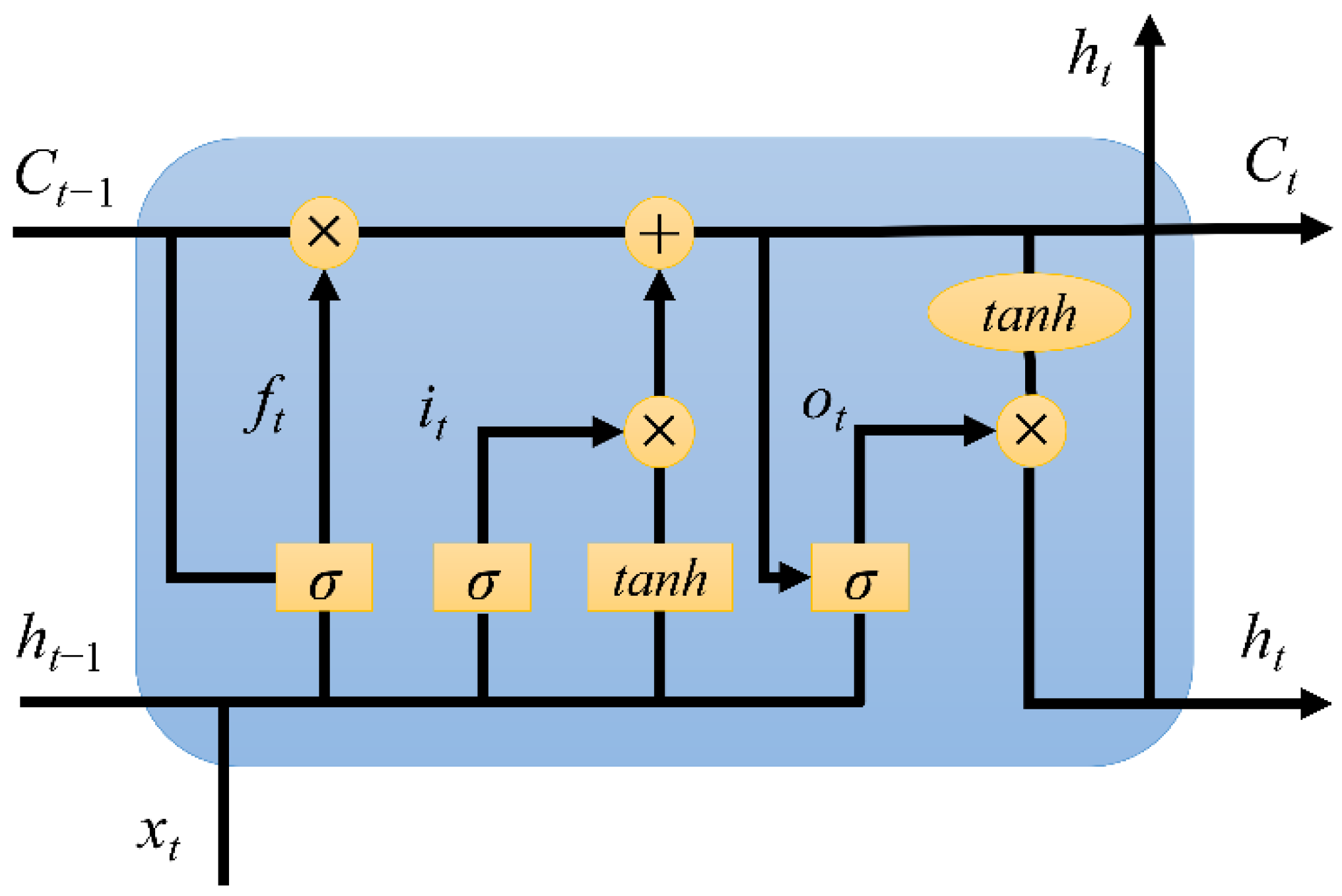
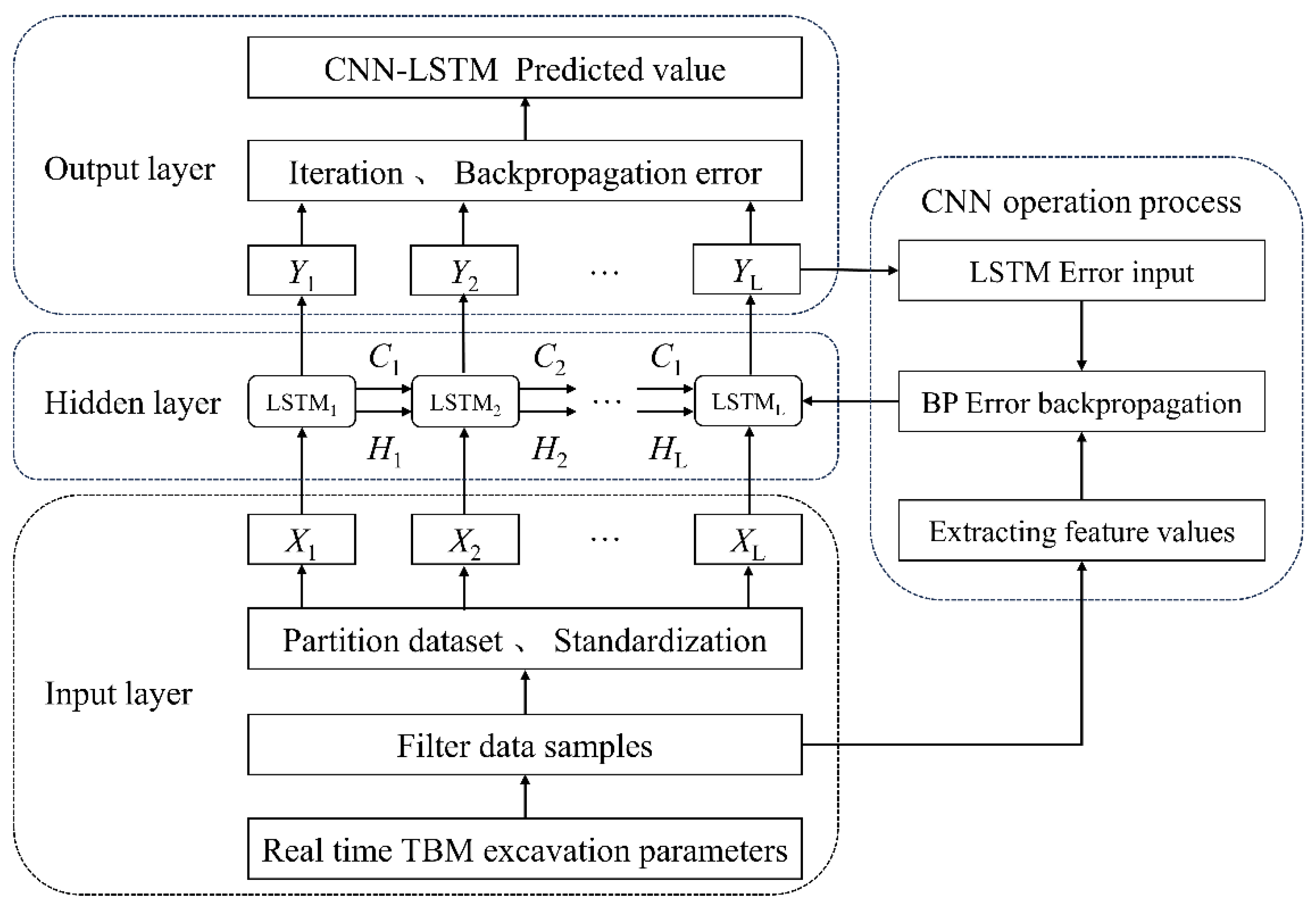
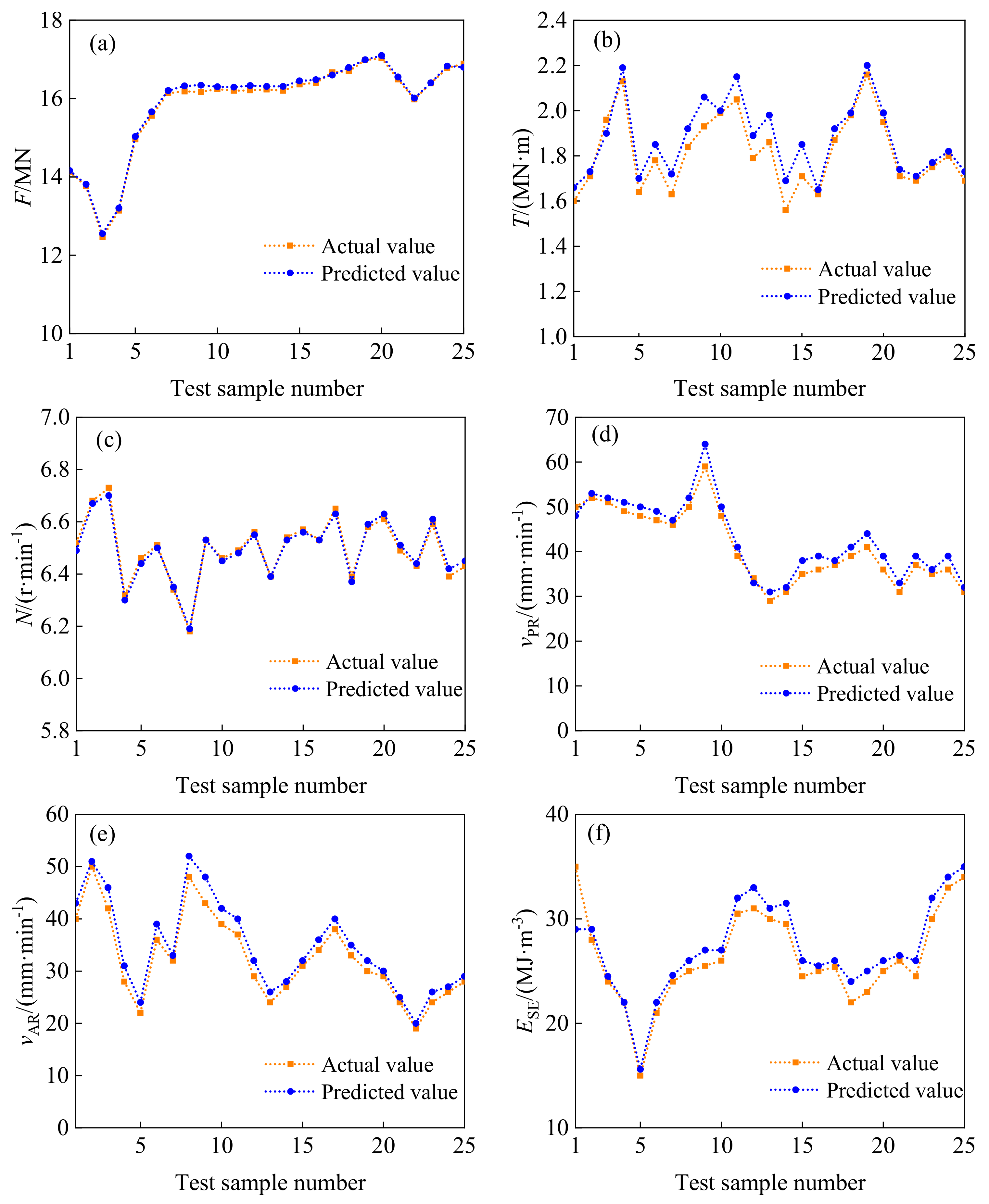
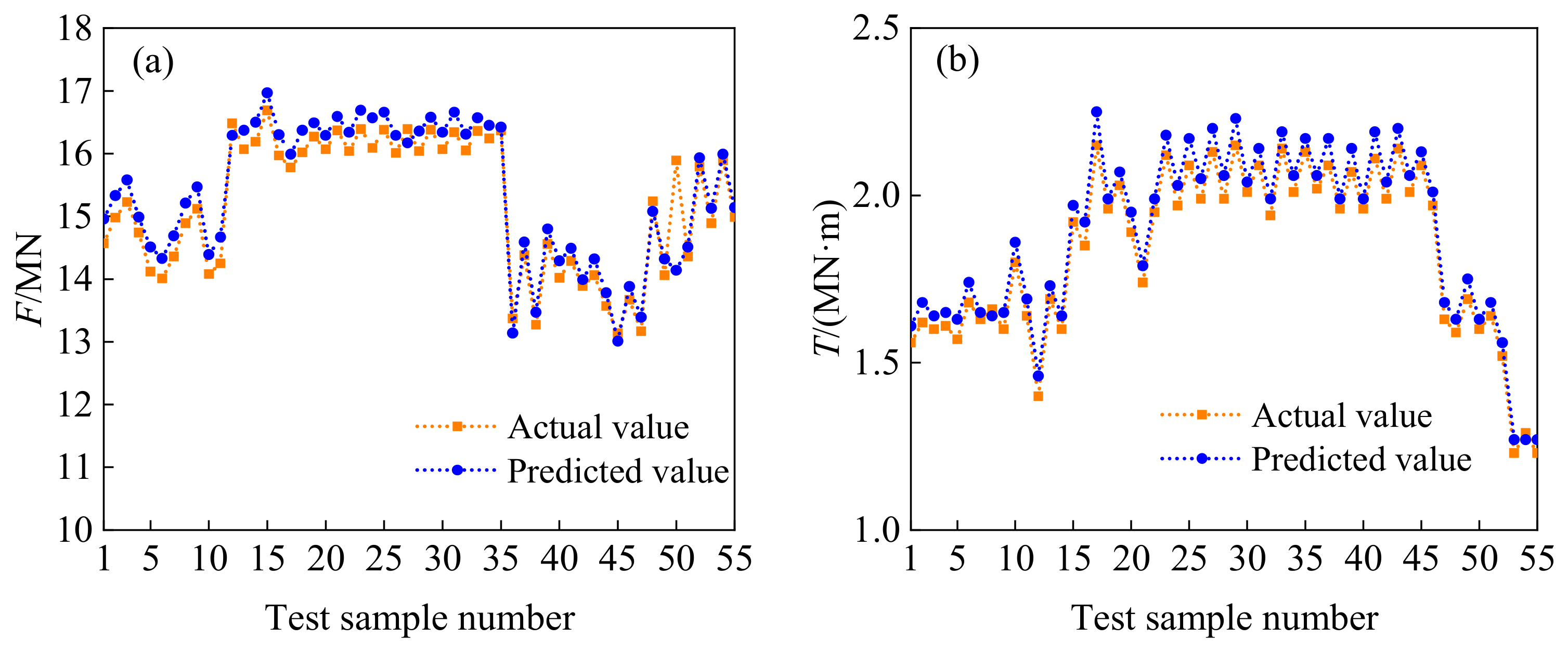

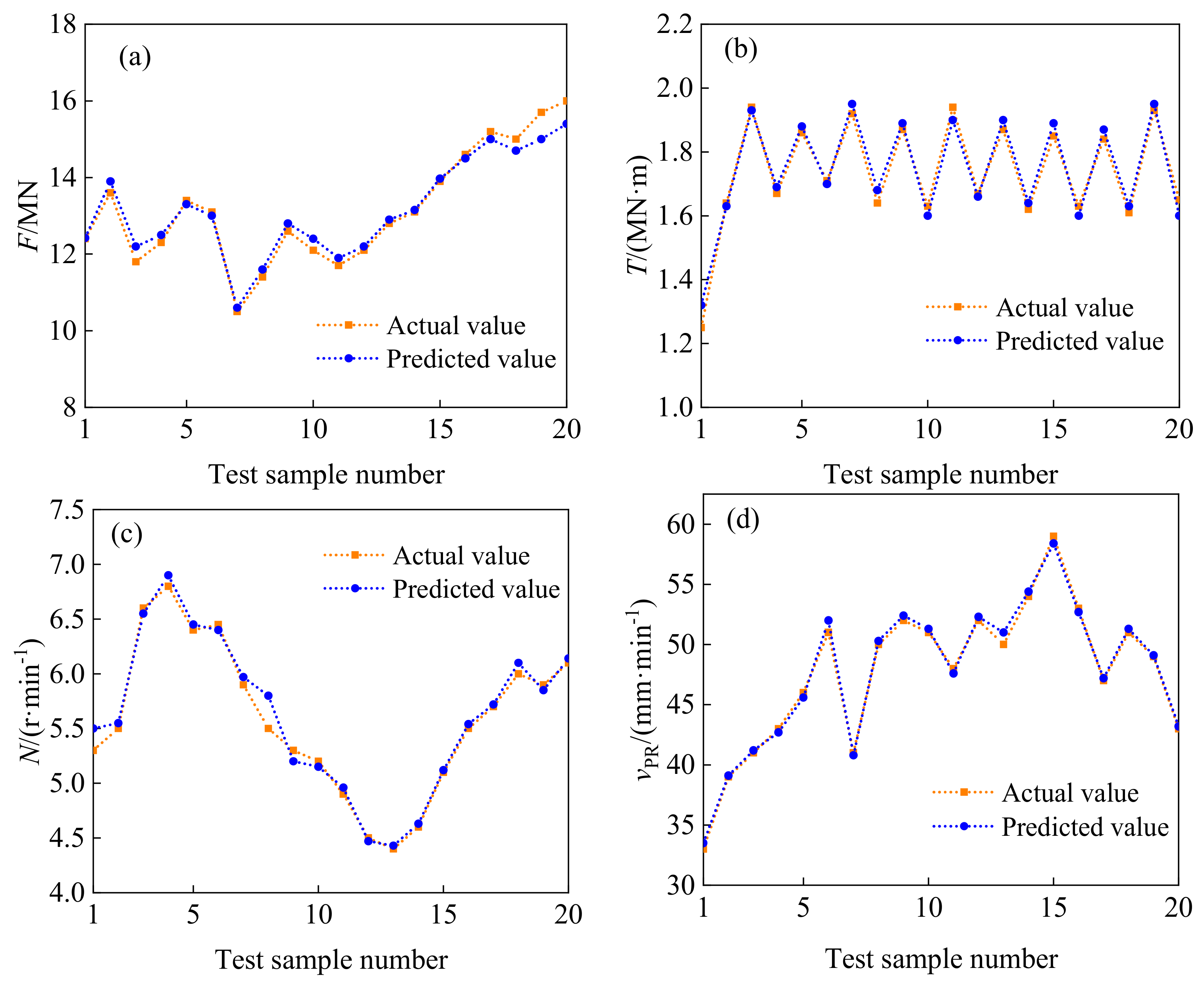


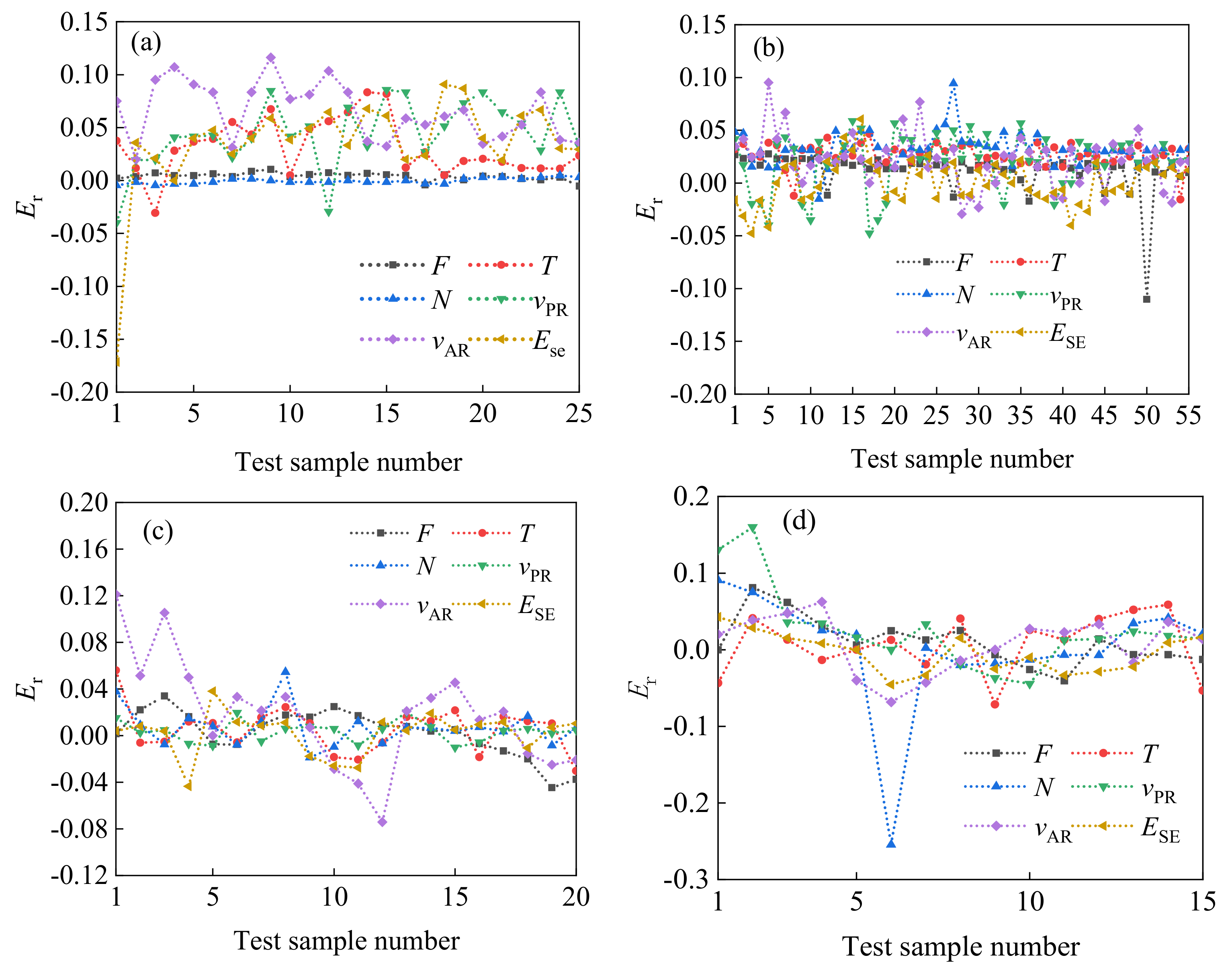

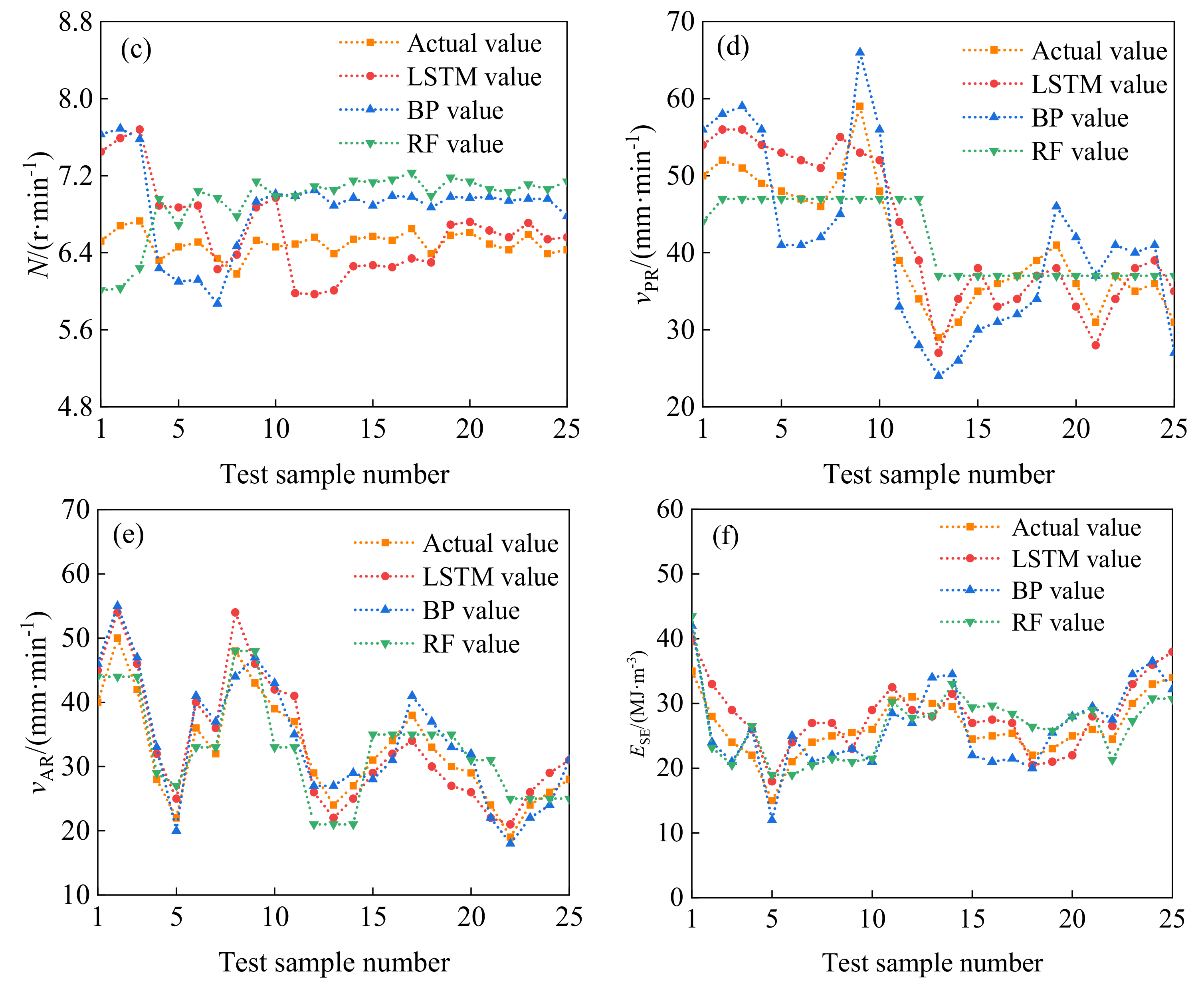
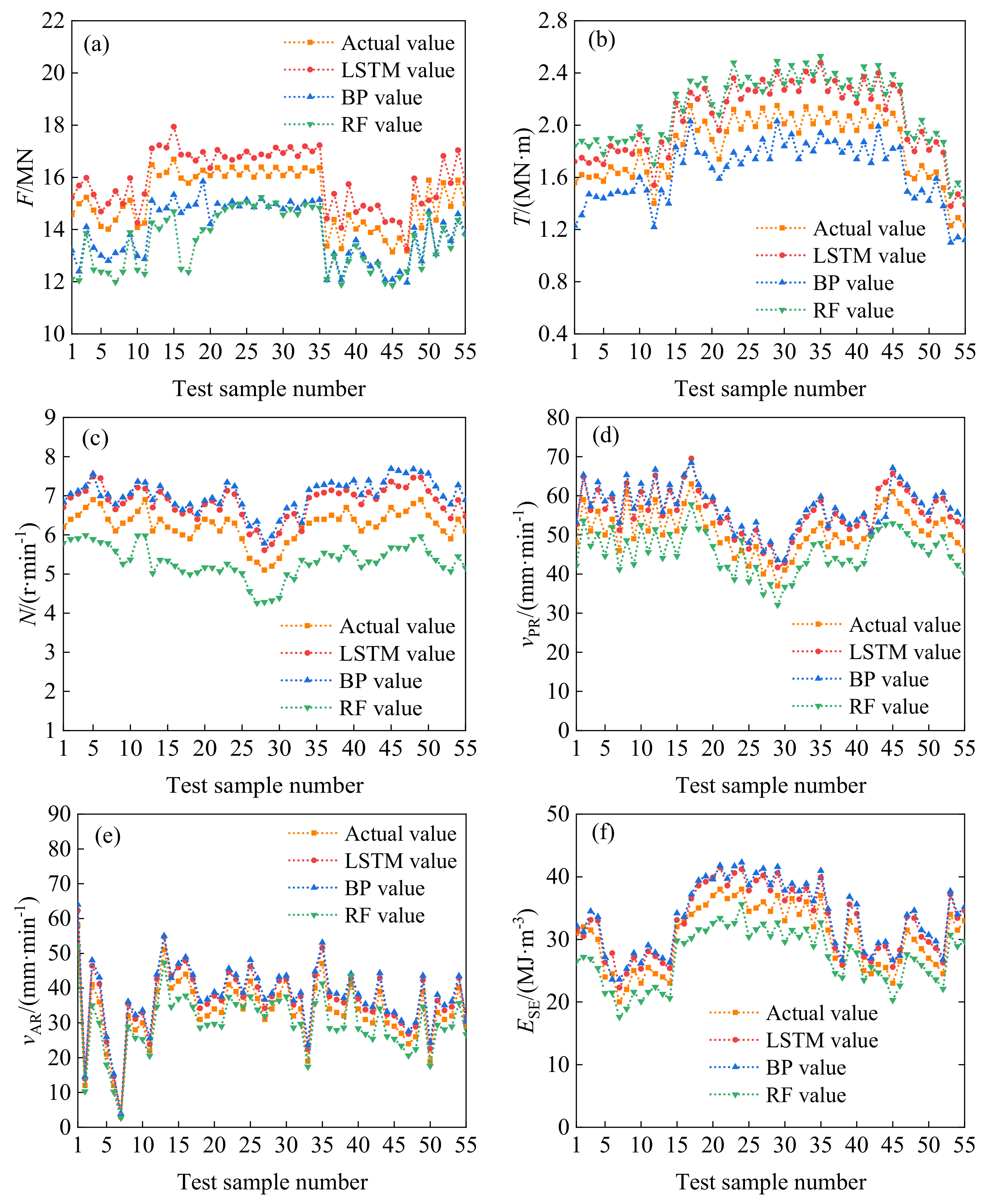

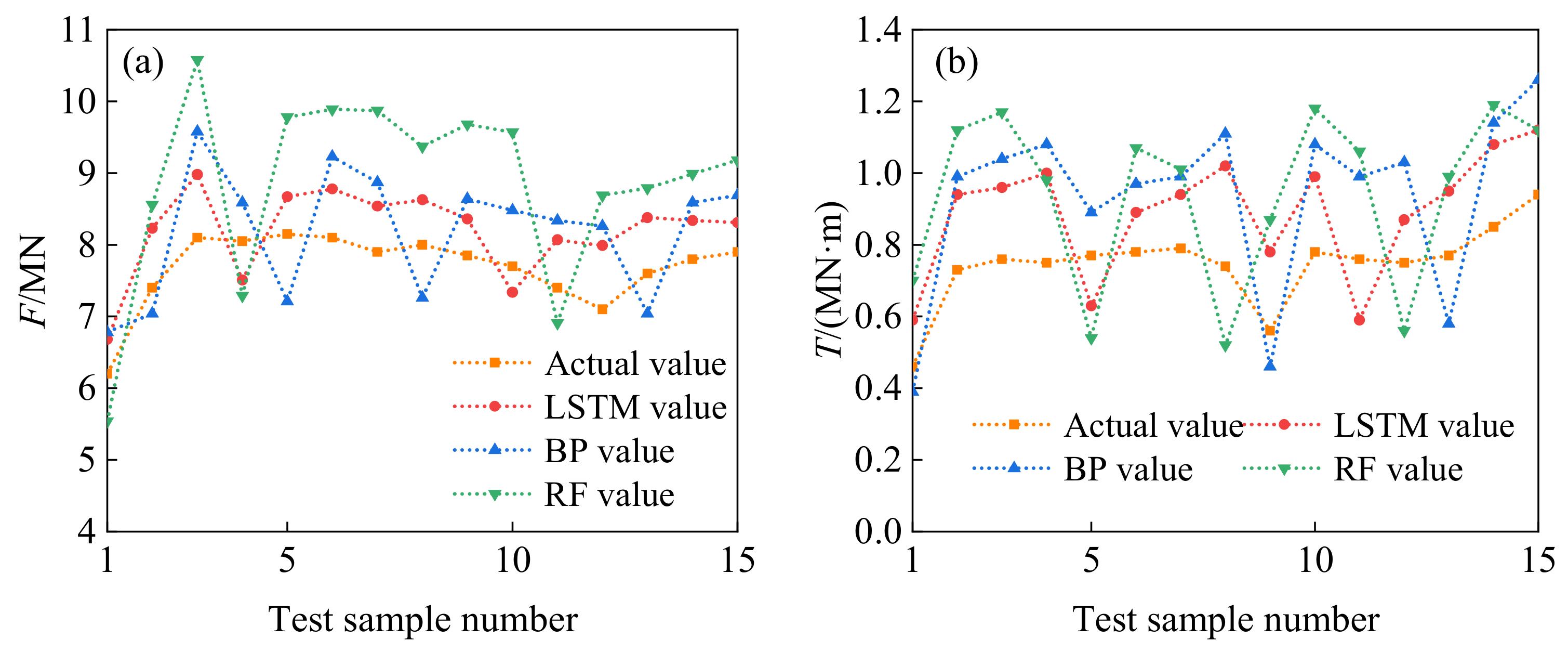
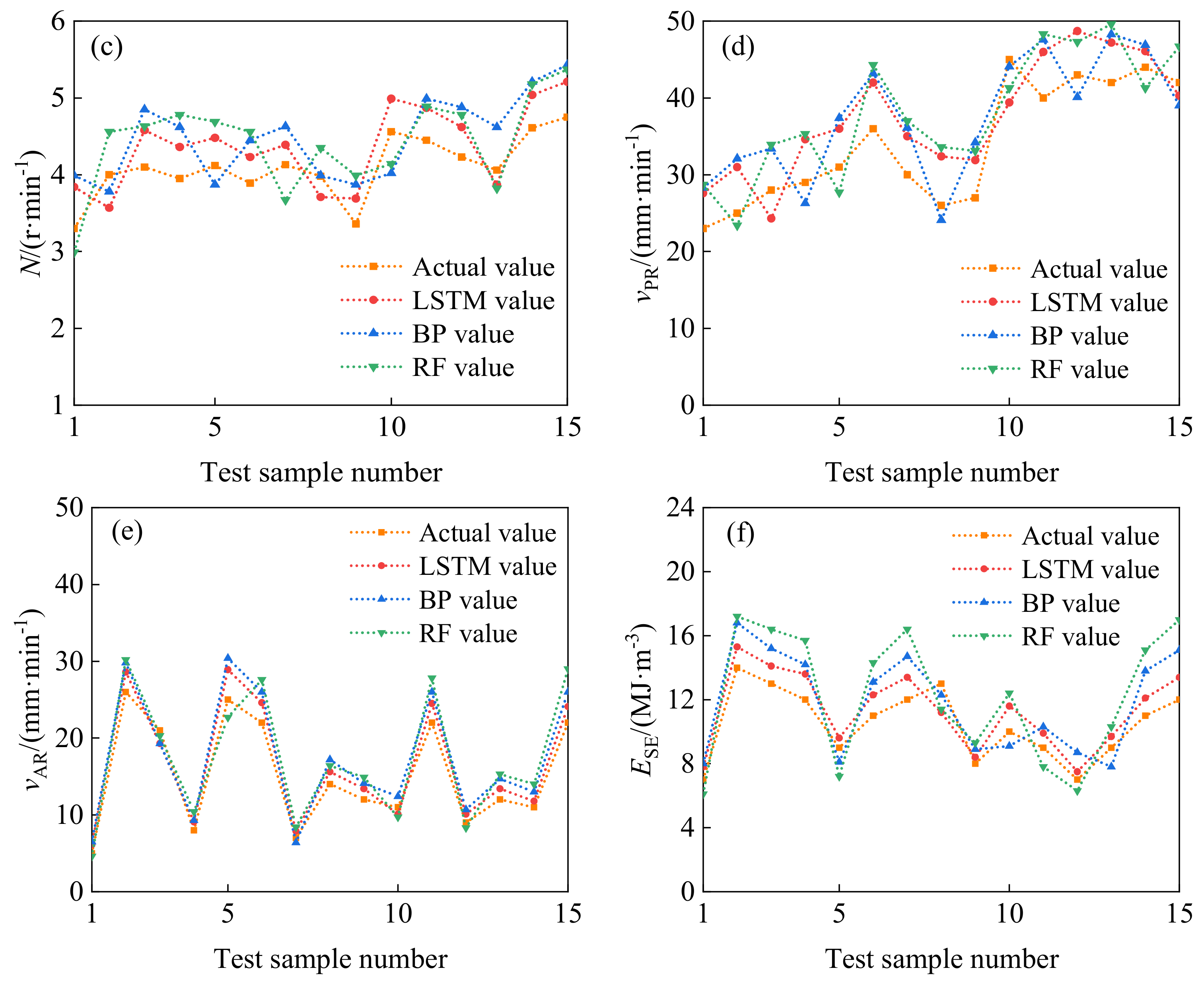

| Rock Grade | Evaluating Indicator | F | T | N | vPR | vAR | ESE |
|---|---|---|---|---|---|---|---|
| II | MAPE/% | 0.925 | 1.241 | 0.782 | 1.783 | 2.384 | 1.671 |
| RMSE | 0.5426 | 1.021 | 1.215 | 1.178 | 1.563 | 1.694 | |
| R2 | 0.991 | 0.984 | 0.945 | 0.902 | 0.957 | 0.934 | |
| Ⅲ | MAPE/% | 1.113 | 2.045 | 1.114 | 2.321 | 3.569 | 2.671 |
| RMSE | 0.5674 | 2.0156 | 3.2471 | 2.9648 | 3.0816 | 2.6948 | |
| R2 | 0.894 | 0.924 | 0.902 | 0.883 | 0.952 | 0.924 | |
| Ⅳ | MAPE/% | 1.034 | 4.059 | 3.148 | 3.367 | 4.697 | 3.987 |
| RMSE | 0.6764 | 2.3157 | 3.1561 | 3.3461 | 3.8149 | 3.7314 | |
| R2 | 0.914 | 0.902 | 0.896 | 0.871 | 0.846 | 0.814 | |
| Ⅴ | MAPE/% | 3.241 | 5.347 | 4.968 | 4.367 | 5.681 | 6.397 |
| RMSE | 0.7963 | 3.6378 | 4.7894 | 4.3697 | 4.1687 | 4.4791 | |
| R2 | 0.871 | 0.882 | 0.874 | 0.843 | 0.846 | 0.795 |
| Model | Rock Grade | |||
|---|---|---|---|---|
| II | Ⅲ | IV | V | |
| LSTM | 4.38% | 3.52% | 4.24% | 8.38% |
| BP | 5.36% | 5.99% | 6.23% | 11.24% |
| RF | 5.44% | 6.34% | 7.49% | 13.04% |
| Rock Grade | Evaluating Indicator | F | T | N | vPR | vAR | ESE |
|---|---|---|---|---|---|---|---|
| II | MAPE/% | 1.3467% | 3.9637% | 3.8236% | 3.2879% | 4.9634% | 8.9678% |
| RMSE | 1.6493 | 8.9634 | 9.6481 | 9.3671 | 8.9658 | 9.9648 | |
| R2 | 0.9756 | 0.9587 | 0.9361 | 0.9564 | 0.9325 | 0.9678 | |
| III | MAPE/% | 2.0473% | 2.2634% | 3.0167% | 3.6794% | 4.3492% | 5.6894% |
| RMSE | 4.6349 | 74.2597 | 78.3691 | 6.3471 | 5.3678 | 8.3487 | |
| R2 | 0.8792 | 0.8467 | 0.8816 | 0.8026 | 0.9247 | 0.9248 | |
| IV | MAPE/% | 2.6719% | 3.0587% | 4.6397% | 4.0364% | 5.5482% | 5.5479% |
| RMSE | 1.3917 | 5.6471 | 6.3492 | 9.6482 | 6.3486 | 9.3256 | |
| R2 | 0.9026 | 0.8143 | 0.9634 | 0.9014 | 0.8461 | 0.8056 | |
| V | MAPE/% | 6.8791% | 7.3679% | 8.9647% | 7.8024% | 8.9634% | 10.3489% |
| RMSE | 1.1583 | 4.4639 | 4.2387 | 4.2934 | 9.6781 | 9.3648 | |
| R2 | 0.8156 | 0.8024 | 0.7934 | 0.9243 | 0.8714 | 0.7624 |
Disclaimer/Publisher’s Note: The statements, opinions and data contained in all publications are solely those of the individual author(s) and contributor(s) and not of MDPI and/or the editor(s). MDPI and/or the editor(s) disclaim responsibility for any injury to people or property resulting from any ideas, methods, instructions or products referred to in the content. |
© 2024 by the authors. Licensee MDPI, Basel, Switzerland. This article is an open access article distributed under the terms and conditions of the Creative Commons Attribution (CC BY) license (https://creativecommons.org/licenses/by/4.0/).
Share and Cite
Jia, Y.; Pei, C.; Dai, M.; Che, X.; Zhang, P. Research on Prediction of Excavation Parameters for Deep Buried Tunnel Boring Machine Based on Convolutional Neural Network-Long Short-Term Memory Model. Buildings 2024, 14, 2454. https://doi.org/10.3390/buildings14082454
Jia Y, Pei C, Dai M, Che X, Zhang P. Research on Prediction of Excavation Parameters for Deep Buried Tunnel Boring Machine Based on Convolutional Neural Network-Long Short-Term Memory Model. Buildings. 2024; 14(8):2454. https://doi.org/10.3390/buildings14082454
Chicago/Turabian StyleJia, Yunfu, Chengyuan Pei, Mingjian Dai, Xuan Che, and Peng Zhang. 2024. "Research on Prediction of Excavation Parameters for Deep Buried Tunnel Boring Machine Based on Convolutional Neural Network-Long Short-Term Memory Model" Buildings 14, no. 8: 2454. https://doi.org/10.3390/buildings14082454
APA StyleJia, Y., Pei, C., Dai, M., Che, X., & Zhang, P. (2024). Research on Prediction of Excavation Parameters for Deep Buried Tunnel Boring Machine Based on Convolutional Neural Network-Long Short-Term Memory Model. Buildings, 14(8), 2454. https://doi.org/10.3390/buildings14082454






